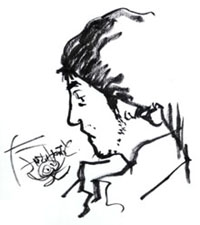The Making of Asience 5 part IV: Kazuto Nakazawa (Director)
Kazuto Nakazawa did not just direct Asience: Hairy Tale. He was also responsible for character design, storyboards, animation directing and key art. The final result is a sixty-second concentrate of Nakazawa-esque themes and elements, and the film received great attention from international festivals throughout the globe. Nakazawa has been extensively involved with Production I.G's projects such as the animation segment in Kill Bill: Vol.1, the second opening sequence for the TV series Blood+, and the award-winning Kirin Lemon Black commercial. While focusing on Asience, we took this opportunity and asked Nakazawa the basics of creating anime by going over the works he directed in the past. This is the fourth and last of our exclusive 4-part interview with one of the most talented animators in the world scene.
 | Kazuto Nakazawa - Born in Niigata Prefecture on March 4, 1968. Animator. After graduating from the Tokyo Animator Gakuin, he joined studio Magic Bus, and later moved to studio Manglobe. His credits include Kill Bill: Vol. 1 (2003, animation sequence director), TV series Samurai Champloo (2004, character design, chief animation director), Linkin Park's video clip Breaking the Habit (2004 MTV VMA Viewer's Choice Award), the commercial film Kirin Lemon Black: Monster Blacks Fights Back (Best Commercial Film at the 11th Holland Animated Film Festival) and the episode Moondrive in Genius Party Beyond (2008). His latest collaboration with I.G is as character designer for the animated feature film Musashi: The Dream of the Last Samurai (2009), directed by Mizuho Nishikubo. |
part IV
When you draw the storyboards, do you have the finished screen in your head?
Sure, I do. I treat storyboards merely as tips. I already have the finished screen in my head, so when I draw the storyboards, I try to show how we should tackle it to realize that.
How do you envision the finished screen? Does it pop up in your head out of the blue?
I mull it over and over. I keep on thinking about it whether I'm walking, eating or playing around. When I'm not at my desk, I keep on thinking about it 24/7. So I try not to drive. I would undoubtedly crash into something. (lol)
So you think it out until you have the finished the screen in your head and then draw the storyboards?
Yeah. Of course, I sometimes don't have the definite picture, but once I have a concept, all I have to do is to sit at my desk and start drawing that concept into images. As for Asience, I completed the storyboards in about two days. People say I am quick, but that's not true because I spend the entire time away from my desk thinking.
Your range of work is extensive not to mention character designing, illustration, key arts, directing, screen directing. Is there a particular job you feel at ease doing?
I'd say the key art. If I could make my living drawing just the key art, I would be a happy animator. The responsibility you have to take as a key artist is less compared to directors and screen directors, so there would be less stress.

In Asience, you did the entire key animation all by yourself.
Because it was the quickest way to handle it. My position allowed me to have an extremely free schedule. I draw fast. We could also omit meetings, because what I drew would be the default drawing and could get the director's OKs instantly. Simply speaking, it was the most effective choice. Mind you, it wasn't that I wanted to do it. (lol) It took me about a week or two. Drawing with brushes was very easy for me, but I gave the in-betweeners a very hard time on that. I owe a lot to them.
Suzuki-san, the production desk manager for Asience, said your working style was, "offhand in a good way." Do you have anything to say to that?
I don't think "offhand" is a bad way to put it in this case. I think we don't have to be that rigid and thorough in animation production. We should allow some messing about. Or else it gets kind of difficult. I wanted to show how to live the "Slow Life" with anime.
You mean "Slow Anime," like "Slow Food." I think that mood encompasses the entire film.
Yeah. One of my focuses is to work hard to create something "offhand." As I often say, making anime does not provide everyday commodities. It's not a vital job, so to speak, but that's exactly why we have to do it right in earnest.
Needless to say, we are told that anime production is very grueling work. Getting back to Suzuki-san, he also said about Asience that, "Nakazawa-san worked unbelievably." How was your day like while in production?
I am just like any salaried worker. I go to work in the morning, work until evening and then go home. I usually don't work through the night and that goes for this production as well. I wake up at six in the morning and start at seven. I probably go to bed at around midnight. If I worked until I am satisfied, I think 24 hours a day is not enough. You really have to consider your working propensity. I would drop dead if I worked through night for two or three days. It is important to remember not to overdo things. You are not living for your work, but you are working to live. So I try to know my limits and boundaries.
Lastly, could you give a message to future animators? Including your secret for working through your day punctually...
Punctuality came only recently. (lol) But if you ask, I think the secret is self-control. What you think is your 100% may necessarily not look 100% to others. That's all.
(5/4 - end)
© 1994-2007 KAO CORPORATION. All Rights Reserved.

![WORK LIST[DETAILS]](/contents/works/design/images/left_title.gif)



 terms of use
terms of use